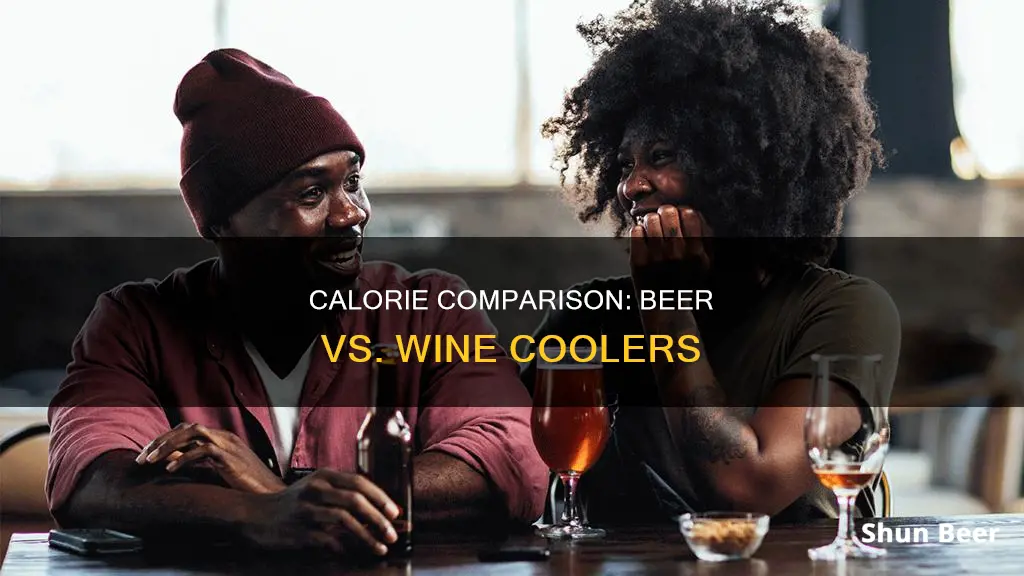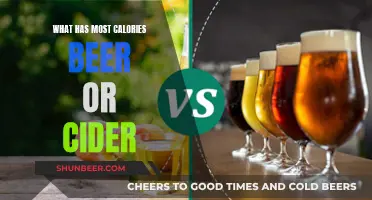
Beer or wine? It's a question that has plagued drinkers for years, and not just in terms of taste. The calorie content of these two drinks has long been a topic of debate, with many wondering which is more fattening. While it's true that individual drinks within these categories may vary, with some beers and wines having higher alcohol percentages than others, there do tend to be general differences between the two. So, which is it?
| Characteristics | Values |
|---|---|
| Beer calories | 140-300 calories per 12 oz |
| Light beer calories | 60-120 calories |
| Beer calories (average) | 150 calories per 5% ABV |
| Beer calories (average) | 239-240 calories per pint |
| Wine coolers calories | 215 calories per 12 oz |
| Sparkling wine calories | 84 calories per 4 oz |
| Wine calories | 121-172 calories per glass |
| Wine calories (average) | 133 calories per 175ml of 12% ABV |
| Wine calories (average) | 150 calories per 6 oz |
What You'll Learn

Beer calories depend on alcohol content, and to a lesser extent, carbs
The alcohol content of a beer is the primary determinant of its calorie count. Very-low-alcohol beers (2% to 3% alcohol) typically start at around 60 calories for a 12-ounce serving. Light beers (4% alcohol) usually have about 100 calories, while regular beers (5% alcohol) average around 150 calories. Heavy hitters like IPAs, double or imperial IPAs, and Belgian-style Trippels, with alcohol content ranging from 7% to 11%, can pack 200 to 300 calories.
The carbohydrate content of beer also contributes to its calorie count, but to a lesser extent than alcohol. The number of grains and added sugars left in the beer after fermentation varies and affects the overall calorie count. Beers with higher carbohydrate content tend to be heavier and have more calories.
The type of beer also plays a role in determining calorie count. Lighter-coloured beers tend to have lower alcohol and ingredient density, resulting in fewer calories compared to their darker counterparts. For example, light beers typically have between 60 and 120 calories, while dark beers can range from 100 to 300 calories.
In summary, the calorie content of beer is influenced primarily by its alcohol content and, to a lesser extent, its carbohydrate content. The type of beer, such as light or dark, also impacts the calorie count. The number of grains and added sugars in the beer, as well as the overall sugar levels, contribute to the carbohydrate content and ultimately affect the total calories in the beverage.
Calories in Lucky Buddha Beer: A Comprehensive Breakdown
You may want to see also

Wines with higher alcohol content have more calories
It's important to remember that the calorie content of wine and beer can vary depending on several factors, such as alcohol percentage, ingredients, and serving size. However, it is generally true that wines with higher alcohol content will have more calories.
Alcohol has 7 calories per gram, so the more alcohol a drink contains, the higher its calorie count. This is why drinks with higher alcohol content, such as heavy-hitter IPAs or double IPAs, tend to have more calories. For example, a typical 12 oz. beer has around 140 calories, while an average 5% alcohol beer like Budweiser hovers around 150 calories.
Wines also follow this trend. A standard 175ml glass of 12% ABV wine contains around 133 calories, while a 5-ounce glass of red or white wine (typically containing around 12% ABV) has about 150 calories. So, if you're comparing a higher-alcohol wine to a lower-alcohol beer, the wine will likely have more calories.
Additionally, the type and colour of wine can also impact its calorie content. Red wines tend to have a slightly higher alcohol content and, therefore, more calories. Rose wine typically has around 70-80 calories per 100ml, white wine has 73-83 calories per 100ml, and red wine can have between 75-85 calories per 100ml.
So, if you're watching your calorie intake, it's worth considering the alcohol content of your drink. Opting for lower-alcohol beverages, such as light beers or sparkling wines, can be a good strategy to reduce your calorie consumption. However, it's important to remember that moderation is key, as alcohol provides zero nutrition and excessive consumption can lead to health issues.
Calories in Red Miller Light Beer: What's the Count?
You may want to see also

Beer has more calories than wine per serving
It is true that beer has more calories than wine per serving. A standard 175ml glass of 12% ABV wine contains around 133 calories, whereas a pint of 5% ABV beer contains around 240 calories, according to the NHS.
The calorie content of beer can vary widely depending on the type of beer. Lighter colour beers tend to contain fewer calories than darker beers, as they have a lower alcohol content and lower ingredient density. For example, most light beers tend to have between 60 and 120 calories, whereas dark beers contain between 100 and 300 calories.
The type and colour of wine also have an impact on the calorie content. Rose wine has around 70-80 calories per 100ml, white wine has 73-83 calories per 100ml, and red wine contains between 75-85 calories per 100ml. Red wine tends to have a slightly higher alcohol content, which is why it usually contains more calories.
The leftover carbohydrates found in beer account for the calorie difference between beer and wine. Wine typically has a low sugar content, whereas beer contains residual sugar. As a result, a pint of beer has around 50% more energy content than a small glass of wine, which can lead to weight gain if consumed in excess.
However, it is important to remember that individual drinks within each category can vary, and other factors such as serving size and food consumption should also be considered when comparing the calorie content of beer and wine.
Calorie Count in Modelo Especial Beer Revealed
You may want to see also

Beer is often served in larger quantities than wine
When it comes to the age-old debate about the health merits of beer versus wine, calorie content is often a key consideration. While individual drinks within each category can vary, with some beers and wines having higher alcohol percentages than others, there are some general assumptions that can be made about their relative calorie contents.
The calorie content of beer can vary widely depending on the type of beer. Lighter colour beers tend to have lower alcohol content and fewer calories, with most light beers ranging from 60 to 120 calories. In contrast, darker beers, such as stout or porter, are more carbohydrate-heavy and can contain up to 300 calories. The alcohol percentage is a key factor in determining the calorie content of beer, with higher alcohol content leading to more calories.
On the other hand, wine is typically consumed in smaller servings, such as a 5-ounce or 6-ounce pour, which is common in restaurants. The calorie content of wine can also vary depending on the type, with sweet wines having a higher calorie count than dry wines. On average, a 5-ounce glass of dry red wine contains 125 calories, while the same serving of dry white wine has approximately 121 calories. Sparkling wine is a lower-calorie option, with around 84 calories per 4-ounce glass.
It is worth noting that the consumption of alcohol in any form should be done in moderation. Alcohol provides zero nutrition and can lead to weight gain, with 7 calories per gram. Additionally, excessive alcohol consumption can have negative health consequences, including liver damage and an increased risk of certain types of cancer. Therefore, it is important to be mindful of serving sizes and overall calorie intake when choosing between beer and wine.
Calories in Kombucha Beer: Nutritional Breakdown and Comparison
You may want to see also

Wine is often consumed with food, beer is not
The calorie count of alcoholic drinks varies by product. Beer and wine have distinct differences in flavour, nutritional values and ingredients. Beer is made using grains and yeast, and the calorie content depends on the type of beer. Lighter colour beers tend to contain fewer calories than their darker counterparts. This is because lighter beers have a lower alcohol content and lower ingredient density. For example, most light beers tend to have between 60 and 120 calories, while dark beers have between 100 and 300 calories. On average, a pint of 5% ABV beer contains around 240 calories.
The type and colour of wine also affect the calorie content. Rose wine has on average around 70-80 calories per 100ml, white wine has 73-83 calories per 100ml, and red wine tends to contain between 75-85 calories per 100ml. This is because red wine tends to have a higher alcohol content, and wines with a higher alcohol content will usually contain more calories than wines with a lower alcohol content. On average, a 5-ounce glass of dry red wine has 125 calories, while the same serving of dry white wine has about 121 calories.
While beer may be more nutritious, wine has fewer calories. So, if you're watching your waistline, choosing wine or light beer could save you some calories compared to regular beer. However, it's important to remember that alcohol provides zero nutrition and can lead to weight gain, so moderation is key.
Calorie-conscious Conundrum: Beer-Battered Fish Dish Calories Explored
You may want to see also
Frequently asked questions
Beer typically has more calories than wine coolers. A pint of beer can range from 153 to 240 calories, while a 12-ounce wine cooler has 215 calories.
The calorie content of beer and wine is influenced primarily by their alcohol content and, to a lesser extent, their carbohydrate and sugar content.
A typical 12-ounce beer has a similar calorie count to a can of Coke, approximately 140 calories.
Yes, light beers and sparkling wines tend to have fewer calories. Light beers have around 60-100 calories, while sparkling wines have about 84 calories per 4-ounce glass.
Excessive alcohol consumption can lead to liver damage and increase the risk of certain types of cancer. Alcohol is also associated with a significant number of deaths each year from causes such as car crashes, suicides, homicides, violence, falls, heart disease, and liver disease.







